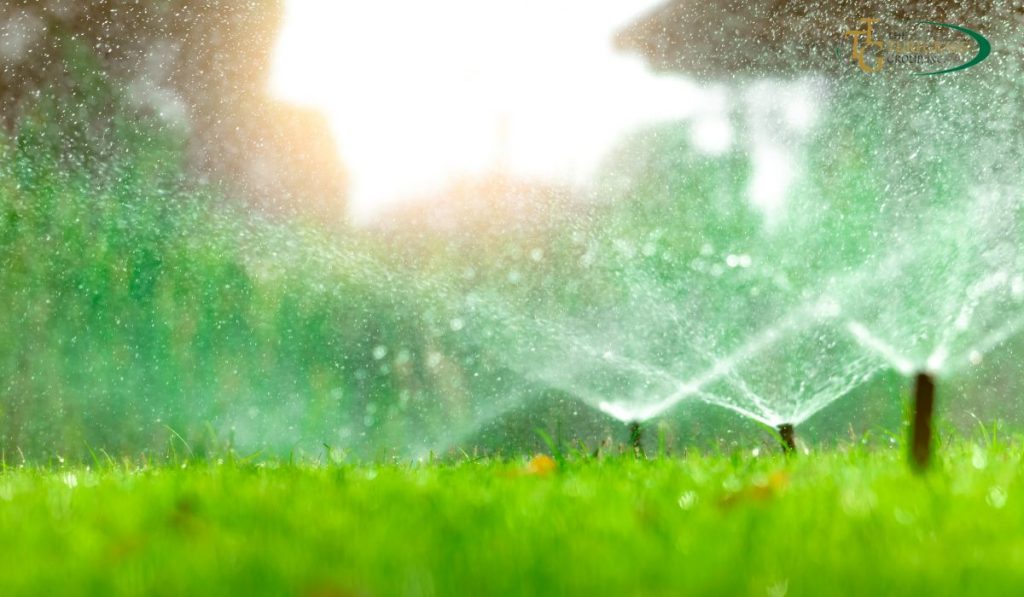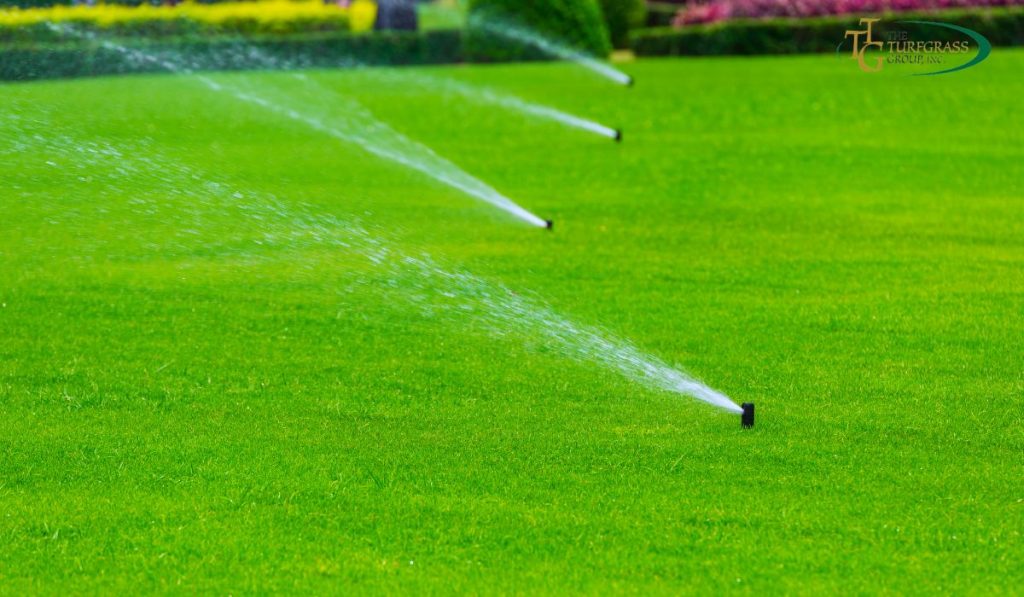
For nearly a half-century, a green lawn has been the hallmark of the suburban home.
It is seen as an indicator of financial success.
But as Americans are becoming more aware of their impact on the environment, some are beginning to question the value of those emerald green expanses.
According to the EPA, “nationwide, landscape irrigation is estimated to account for nearly one-third of all residential water use, totaling nearly 9 billion gallons per day.”
For comparison, New York City uses about 1 billion gallons of water a day.
So Americans are spending nine New York Cities of water every day just to water their plants.
What’s worse is that nearly half of that water is wasted on overwatering, runoff, and other uses that do nothing to enhance the landscape.
But conservation doesn’t have to mean giving up your lawn.
As we stare down this tremendous waste of water, it is time we talk seriously about how to use less water on your lawn.
Picking the Right Grass
Before we can talk about better watering practices, we have to address the bottom line.
Growing grass takes a lot of water.
But just how much can vary greatly depending on what variety you grow.
Some grasses thrive on less water than others, and drought resistance varies greatly.
There are two main measures of how well grass grows with less water.
First, some grasses will stay green longer than others in a period of drought.
Second, some grasses are particularly suited to going dormant during drought and bouncing back when the water returns.
A significant factor in how well your grass survives a low-moisture environment is how healthy it was to start with.
Grass with deep roots can access water deeper underground and stay green longer even as the surface dries out.
Grass that is well-suited for the climate is also much more likely to survive dry weather.
Cool-season grasses are perfect for the northern half of the US.
They grow well where summers are temperate and winter sees many days of below-freezing temperatures.
This includes Northern California, the Pacific Northwest, the upper Great Plains, the upper Midwest, and New England.
Warm-season grasses are best suited for climates with hot summers and mild winters.
This includes the Deep South and the Southeast.
Between these two climate zones lies a transition zone that stretches from Southern California east to the Virginias.
In these regions, you can use either warm-season or cold-season grasses, and many lawns are overseeded with a mixture of warm and cold-season varieties.
Cool-Season Grasses That Use Less Water
Fine fescue is the gold standard in low-water cool-season grasses.
In good times, it only needs about 0.75 to 1 inch of water a week.
It has a great look, with thin, dark green blades that recover quickly from drought damage.
Tall fescue also grows well with less water.
It requires about 1 to 1.25 inches of water a week, and its deep roots help it sustain extended drought conditions.
Kentucky bluegrass is very popular in the cool-season climate zone.
It has a beautiful bright green color and needs about 1 to 1.5 inches of water a week.
Its underground rhizomes help it bounce back from drought damage and quickly turn green again after going dormant.

Warm-Season Grasses That Use Less Water
Bermudagrass is the most drought-resistant of all warm-season grasses.
It needs about 1 to 1.25 inches of water a week, which can come from rain or irrigation.
But what makes Bermudagrass so drought-resistant is the way it uses the water.
With roots that can grow up to six feet deep in the right conditions, Bermudagrass can take water from deep underground.
This allows it to stay green and healthy for up to 50 days of drought.
After that, the grass will turn brown and go dormant.
It can remain dormant for up to 4 weeks and still come back healthy and green when water returns.
In all, that means that Bermudagrass can survive for 11 weeks in drought conditions and still green up again when water returns.
One of the most drought-tolerant varieties is TifTuf™ Bermudagrass, available exclusively from The Turfgrass Group.
Zoysia grass is also a favorite drought-tolerant warm-season grass.
It can stay green for up to 30 days in a drought, after which it can remain dormant for four weeks and still green up when water returns.
It only needs one-half to one inch of water in good times, which is usually supplied by rain.
Zoysia grass is also shade-tolerant and can grow well in partial shade.
One of the most drought-tolerant varieties of Zoysia grass is JaMur™, available from The Turfgrass Group.
St. Augustine grass is another popular drought-tolerant warm-season grass.
It needs about one inch of water a week.
It can stay green for about 45 days in a drought and go dormant for another three to four weeks.
Tips to Use Less Water on Your Lawn
In addition to selecting drought-tolerant grasses, you can reduce your water usage by adjusting how you irrigate and maintain your lawn.
Mowing to Use Less Water on Your Lawn
One way to minimize water waste on your lawn and get the most out of your irrigation is to keep grass long.
Depending on the variety you choose, the maximum length may range from 1.5 inches to 3 inches.
Keeping your grass at the maximum recommended length will help shade the soil to retain more moisture.
Another way to conserve water is to leave the clippings on your lawn when you mow.
The clipping help shade the soil and hold in moisture.
As the clippings break down, they also return precious water and nutrients to the soil.
As your grass absorbs those nutrients, it can grow deeper, healthier roots that can tap into water deeper underground.
Amending the Soil to Use Less Water on Your Lawn
The best time to amend your soil is before you lay down the turf, as it can be difficult to make changes after your turf is established.
To hold in moisture, make sure that your soil has a generous proportion of loose organic matter, such as manure, compost, or high-quality hummus.
The layer of organic matter can absorb and retain water better than clayey or sandy soil.
This is especially critical if you are starting with sandy soil.
Sandy soil tends to drain very quickly, making it hard for your grass to get the most out of your irrigation or even rainwater.
After your turf is established, one of the best ways to make the most of rain and irrigation is to avoid compacted soil.
When soil is too compacted, water can pool on top or run off.
Aerate once or twice a year to maintain soil loose enough to absorb water efficiently.
Watering Practices to Reduce Water Use
The most significant change you can make to use less water on your lawn is not to irrigate when your grass doesn’t need it.
Your grass only needs about one inch of water a week, depending on the variety.
It doesn’t matter whether that water comes from rain or irrigation.
So if it rains, skip irrigating for that week.
If you really want to stay on top of your turf’s water needs, you can install a smart irrigation system.
Modern smart irrigation systems can take into account weather and soil conditions to only irrigate when necessary and save water when the soil is already moist.
If you aren’t ready to invest in a fancy smart irrigation system, you can still be smart about how you water.
It is best to water in the early morning when the weather is coolest, and the least amount of water is lost to evaporation.
Although it may be cooler in the evening or at night, it is not recommended to water at night.
When you water after sunset, the grass can’t dry properly, and you create an environment that favors fungal growth.
Growing grass can use a lot of water, but it doesn’t have to.
If you use the right varieties and cultural practices, you can use less water on your lawn without sacrificing your beautiful green turf.
Conclusion
In conclusion, as the awareness of environmental impact grows, it’s becoming evident that traditional lawn maintenance practices may not be sustainable in the long run.
The vast amounts of water used to maintain lush, green lawns can lead to unnecessary wastage and contribute to water scarcity issues.
However, the solution doesn’t necessarily mean giving up your lawn altogether.
By making thoughtful choices regarding grass varieties, lawn care practices, and irrigation techniques, you can significantly reduce water usage without compromising the beauty of your outdoor space.
FAQs
How can I reduce water usage while maintaining a green lawn?

Reducing water usage while maintaining a green lawn involves selecting drought-resistant grass varieties, practicing proper lawn care techniques, and implementing efficient irrigation methods. By opting for grasses that require less water and adopting practices such as leaving grass clippings and amending soil, you can effectively lower water consumption.
What are the best grass varieties for drought resistance?
Cool-season grasses like fine fescue and tall fescue, as well as warm-season grasses like Bermudagrass, Zoysia grass, and St. Augustine grass, are known for their drought resistance. These grasses have adapted to thrive with minimal water, making them excellent choices for water-conscious lawn owners.
Is it better to keep grass long for water conservation?
Yes, maintaining grass at the maximum recommended length shades the soil, reducing water evaporation and promoting moisture retention. Longer grass also develops deeper roots, allowing it to access water from deeper soil layers during dry periods.
How can leaving grass clippings benefit soil moisture?
Leaving grass clippings on the lawn after mowing acts as a natural mulch, helping to shade the soil and retain moisture. As the clippings decompose, they return nutrients to the soil, promoting healthier root growth and better water absorption.
What’s the significance of soil amendment in water conservation?
Amending soil with organic matter like compost or hummus improves its water-holding capacity. This helps prevent water runoff and allows the soil to retain moisture, reducing the need for frequent watering.
How does soil compaction impact water absorption?
Compacted soil prevents efficient water absorption and encourages water pooling on the surface or runoff. Regular soil aeration maintains soil structure, ensuring water penetration and reducing water wastage.
What are the benefits of a smart irrigation system?
Smart irrigation systems use data on weather conditions, soil moisture, and plant water needs to deliver water only when necessary. This targeted approach optimizes water usage, preventing overwatering and conserving water resources.
Is it advisable to water the lawn at night?
While watering at night may seem beneficial, it can create conditions conducive to fungal growth due to prolonged moisture. Watering in the early morning is preferred, as it minimizes water loss through evaporation and gives the grass ample time to dry during the day.
Can warm-season grasses survive extended periods of drought?
Yes, warm-season grasses like Bermudagrass, Zoysia grass, and St. Augustine grass have developed drought-resistant mechanisms to withstand extended dry periods. Their deep root systems and ability to go dormant contribute to their survival in challenging conditions.
How can I determine if my lawn is receiving adequate water?
A general rule is to provide about one inch of water per week, including rainfall. You can use a rain gauge or a container with straight sides to measure the amount of water your irrigation system delivers in a given time. Regularly monitor the moisture level of the soil to ensure it remains adequately hydrated without becoming waterlogged.